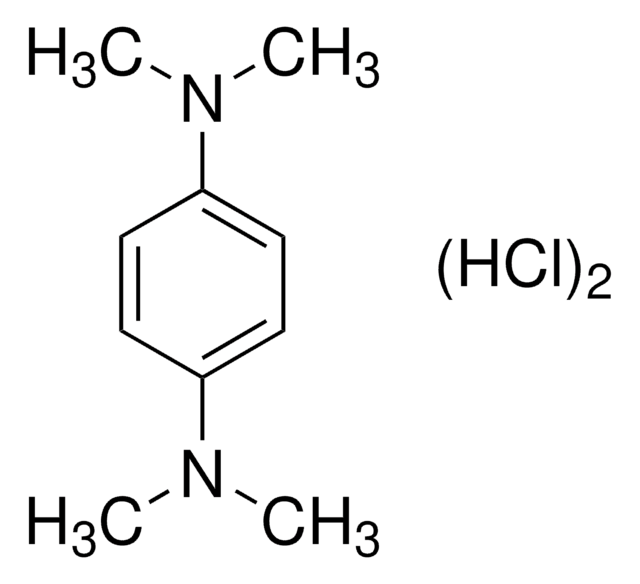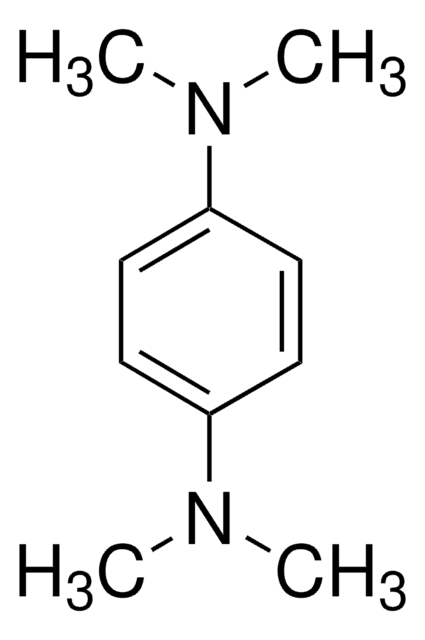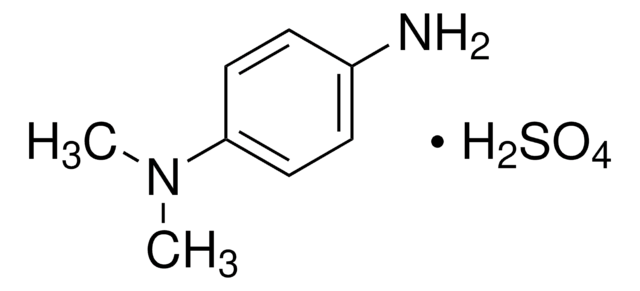Wichtige Dokumente
07770
N,N-Dimethyl-p-phenylendiamin -dihydrochlorid
suitable for microbiology, ≥99.0%
Synonym(e):
4-Amino-N,N-dimethylanilin -dihydrochlorid, DMPD · 2HCl, DMPPDA · 2HCl
About This Item
Empfohlene Produkte
Qualitätsniveau
Assay
≥99.0% (AT)
≥99.0%
Form
powder
Verlust
≤0.05% loss on ignition
mp (Schmelzpunkt)
210-215 °C (dec.)
222 °C (dec.) (lit.)
Kationenspuren
Ca: ≤10 mg/kg
Cd: ≤5 mg/kg
Co: ≤5 mg/kg
Cr: ≤5 mg/kg
Cu: ≤5 mg/kg
Fe: ≤5 mg/kg
K: ≤50 mg/kg
Mg: ≤5 mg/kg
Mn: ≤5 mg/kg
Na: ≤500 mg/kg
Ni: ≤5 mg/kg
Pb: ≤5 mg/kg
Zn: ≤5 mg/kg
Anwendung(en)
food and beverages
microbiology
SMILES String
Cl[H].Cl[H].CN(C)c1ccc(N)cc1
InChI
1S/C8H12N2.2ClH/c1-10(2)8-5-3-7(9)4-6-8;;/h3-6H,9H2,1-2H3;2*1H
InChIKey
IAEDWDXMFDKWFU-UHFFFAOYSA-N
Suchen Sie nach ähnlichen Produkten? Aufrufen Leitfaden zum Produktvergleich
Allgemeine Beschreibung
Anwendung
Vorsicht
Signalwort
Danger
H-Sätze
Gefahreneinstufungen
Acute Tox. 3 Dermal - Acute Tox. 3 Inhalation - Acute Tox. 3 Oral
Lagerklassenschlüssel
6.1A - Combustible acute toxic Cat. 1 and 2 / very toxic hazardous materials
WGK
WGK 3
Persönliche Schutzausrüstung
Eyeshields, Faceshields, Gloves, type P2 (EN 143) respirator cartridges
Hier finden Sie alle aktuellen Versionen:
Analysenzertifikate (COA)
Die passende Version wird nicht angezeigt?
Wenn Sie eine bestimmte Version benötigen, können Sie anhand der Lot- oder Chargennummer nach einem spezifischen Zertifikat suchen.
Besitzen Sie dieses Produkt bereits?
In der Dokumentenbibliothek finden Sie die Dokumentation zu den Produkten, die Sie kürzlich erworben haben.
Kunden haben sich ebenfalls angesehen
Unser Team von Wissenschaftlern verfügt über Erfahrung in allen Forschungsbereichen einschließlich Life Science, Materialwissenschaften, chemischer Synthese, Chromatographie, Analytik und vielen mehr..
Setzen Sie sich mit dem technischen Dienst in Verbindung.










